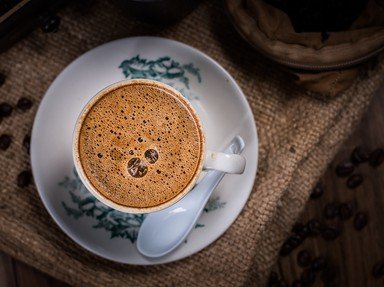Quiz Answer Key and Fun Facts
1. Grown primarily in a two-mile strip of land on an island, this uncommon ground is commonly worshipped as "kona." From which "big island" does this coffee waft?
2. I'd give these grounds a blue ribbon, personally. One of the most expensive and sought after beans, this mild brew is produced high on an island mountain. Due to its rarity, it is usually found blended into "high mountain" beans. Regardless of its bean purity, it is still smooth and mild in the cup, not a knock-it-out cold type of jolt.
3. Hailing from an Indonesian island, this bean is prone to over-roasting. In the raw, the bean is fat and green, but it dries to a dark green. After drying, roasting begins and the best grounds come from a "mottled" appearance on the bean. Due to the majority of these beans being hand-picked and processed, this earthy brew is prone to inconsistency from cup-to-cup.
4. Carried to South America by the Jesuits, this country exploded in coffee production as the cultivation of coffee was actually given as a penance during confession by the local clergy. Sneaky priests must have known that the climate was perfect for producing consistent beans with a distinct taste. Between the coffee and the blow, pick your poison.
5. Originally the number one cash crop on this rich coast, coffee is still a top export. These beans are high in caffeine, thus often blended with other beans. The beans were initially imported from Arabia through Europe to this Central American country, thriving as the government gave land to any farmer willing to raise the crop.
6. Bom dia! The world's largest producer of coffee, this South American country grows beans in vast quantities in the south. The majority of its beans are used by American companies Sara Lee and Kraft foods (owners of Maxwell House). Legend has it that the earliest plants were charmed from the First Lady of French Guiana by an envoy from the government.
7. Bonjour! The world's third largest producer of coffee beans, this African country primarily grows Robusta for export to France and Italy for use in espresso. Economic and political turmoil has harmed the production of beans here as aging coffee plantations are not cared for properly, reducing their yield.
8. Home of the finest Arabica beans in the world, the grounds from this African country are grown at high elevations in volcanic soils. The beans are pulped, fermented, and dried to a "bluish" color. The country utilizes a unique grading system with the highest quality being "peaberry," followed by "AA+" (highest quality grown on a single plantation).
9. I'd run fast and far for a cup of this country's java. Coffee plants are native to this next country, where it still grows wild. Legend has it that goat herders discovered the beans in the region called "Kaffa" (from which the word "coffee" is derived). It wasn't long and the bean spread north and east to Yemen where it was embraced by the Middle East that traded it worldwide.
10. A study of uncommon grounds would not be complete without the rarest beans on earth. Kopi luwak is produced on an island chain and is famous for being partially processed through the gut of a native cat, the Asian palm civet. Upon excretion, the beans are collected, washed, and roasted. Due to this complicated process and a limited supply, Kopi luwak beans are the most expensive grounds in the world, selling for hundreds of dollars per pound. From which island chain does this uncommon ground hail?
Source: Author
TemptressToo
This quiz was reviewed by FunTrivia editor
WesleyCrusher before going online.
Any errors found in FunTrivia content are routinely corrected through our feedback system.

